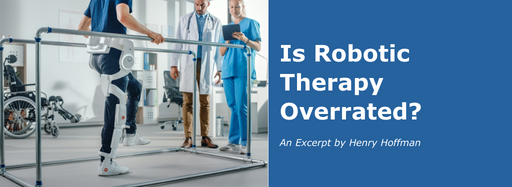
Is Robotic Therapy Overrated?
What Does the Research Say About Robotic Therapy?
The Canadian Partnership for Stroke Recovery, led by Dr. Robert Teasell, examined the relevant RCT’s pertaining to robotics and have concluded that robot-assisted therapy, although shows promise, demonstrated “mixed” or “inconclusive” results, rather than "beneficial." According to Dr. Teasell, an intervention is only considered “beneficial” when two-thirds (66%) of the studies report a positive effect. Should hospitals spend, in many cases, hundreds of thousands of dollars on technologies that show “inconclusive” results? With respect to the upper extremity, the research is clear that interventions including, but not limited to, mirror therapy (47 RCT’s), mental practice (21 RCT’s), task training (25 RCT’s) and CIMT (63 RCT’s) have proven to be “beneficial” (two-thirds or greater of the studies showed a positive effect). How much of a priority should be given to robot-assisted therapy if patients can take part in inexpensive proven concepts mentioned above? Some may argue that robotics are needed for early initiation of movement for individuals with severe hemiparesis (early Brunnstrom stages). That may be the intent, however, research does not support this notion. Additionally, less expensive alternate solutions such as spring-based arm/hand supports and electrical stimulation can be used. While there may be benefits to offering robot-assisted therapy interventions to patients suffering from neurological injuries, one should take a step back and look at the larger continuity of care conundrum.Focusing On At-Home Care
Most of the progress made by a stroke survivor will take place at home. Even if robot-assisted therapy was proves to be beneficial, or superior to other efficacious treatment approaches, the overwhelmingly majority of patients cannot afford to purchase a robotic device for their home program. Perhaps, for the time being, researchers, hospital administrators and clinicians should “reset” the working assumption on why robotics are integrated into the healthcare system and offer more clear expectations. Imagine how much this industry could accomplish if a fraction of the capital dollars spent on robotics was put into creating affordable solutions that can realistically be accessible to patients from the acute setting to the home.Want to Learn More About Stroke Therapy?
Saebo offers a variety of resources focused on stroke education as well as recovery. Check out some of our most recent articles here!All content provided on this blog is for informational purposes only and is not intended to be a substitute for professional medical advice, diagnosis, or treatment. Always seek the advice of your physician or other qualified health providers with any questions you may have regarding a medical condition. If you think you may have a medical emergency, call your doctor or 911 immediately. Reliance on any information provided by the Saebo website is solely at your own risk.
All content provided on this blog is for informational purposes only and is not intended to be a substitute for professional medical advice, diagnosis, or treatment. Always seek the advice of your physician or other qualified health providers with any questions you may have regarding a medical condition. If you think you may have a medical emergency, call your doctor or 911 immediately. Reliance on any information provided by the Saebo website is solely at your own risk.


